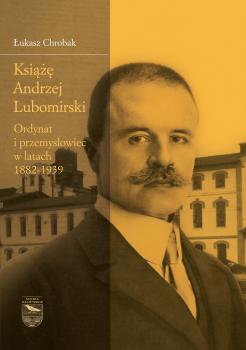Książę Andrzej Lubomirski : ordynat i przemysłowiec w latach 1882-1939
Synopsis
PRINCE ANDRZEJ LUBOMIRSKI: A LANDED ARISTOCRAT AND INDUSTRIALIST IN THE YEARS 1882-1939
Andrzej Lubomirski is a descendant of the Lubomirski family entail from Przeworsk, a well-known branch of this noble family. His grandfather Henryk and father Jerzy were the literary curators of the National Ossoliński Institute in Lviv and greatly contributed to its development. The nineteenth century was a time of dynamic industrial development, including the sugar industry. Polish territories during the Partitions period developed unevenly; Galicia, in which the Austrian and Czech capitals dominated the local market, was in the worst situation. The aristocracy, holding conservative economic views, neglected its property. Few tried to create new industrial plants, including modern sugar factories, in the Austrian partition. Unfortunately, their businesses failed due to the strong competition from Austrians and Czechs. Prince Lubomirski modernized the property of the Lubomirski family entail from Przeworsk by introducing new crops and, above all, by implementing new tillage techniques, which utilised modern, at that time, machines. He established several factories on the premises, such as a brickyard, an alcohol factory, and a cheese factory. In addition, he created three sugar factories during his lifetime: in Przeworsk, Żuczka, and Horodenka. What is equally important, he saved them from bankruptcy. In Lviv, he also managed to save the „Perkun” machine factory from bankruptcy; he modernized it and then expanded its production. Unfortunately, Lubomirski was sometimes very naive during his industrial activity. He was deceived by one of his directors, who caused financial problems at the Lviv factory. However, Lubomirski saved it by merging it with the Zieleniewski factory. At the same time, he formed associations which aimed at supporting Polish investors and novice industrialists. World War I led to many damages; hence, Lubomirski had to rebuild his businesses. During the Second Polish Republic, he tried to continue supporting the Polish industry by being financially involved in various enterprises. He was involved in the formation of a new sugar factory, a rubber factory in Bydgoszcz, and the Lubomirski family entail from Przeworsk started generating income once again. During the Great Depression, he lost the controlling interest in the sugar company, while the family entail was placed under compulsory administration. However, this concerned only his debts; the family entail and the sugar company performed very well despite the omnipresent crisis. The causes of the business problems were numerous misunderstandings in the family, a conflict with his brother, and the irresponsibility of his son, Jerzy Rafał Lubomirski. Before World War II, he tried to pay off the debts and make further investments. After 1939, he almost completely lost influence on his businesses. He had to emigrate in 1944; he died in 1953 in Brazil.
Chapters
-
TABLE OF CONTENTS
-
Słowo wstępne Starosty Przeworskiego .......... 7
-
Słowo wstępne Burmistrza Miasta Przeworska .......... 9
-
Słowo wstępne Dyrektora Muzeum w Przeworsku .......... 11
-
Wstęp .......... 13
-
ROZDZIAŁ I. KORZENIE RODZINNE ANDRZEJA LUBOMIRSKIEGO. ZARYS DZIEJÓW RODU LUBOMIRSKICH .......... 49
-
1.1. Genealogia rodu Lubomirskich .......... 31
-
1.2. Lubomirscy w Przeworsku – linie przeworska i łańcucka .......... 35
-
1.3. Przeworska linia ordynacka .......... 36
-
ROZDZIAŁ II. DZIAŁALNOŚĆ KSIĘCIA ANDRZEJA LUBOMIRSKIEGO W LATACH 1882-1918 .......... 49
-
2.1. Wczesne lata i przejęcie obowiązków ordynata przeworskiego .......... 49
-
2.2. Przeworska inicjatywa cukrowa .......... 69
-
2.3. Walka z wrogimi kartelami .......... 95
-
2.4. Myśl Andrzeja Lubomirskiego o polskim przemyśle .......... 110
-
2.5. Pierwsza inicjatywa przemysłowa .......... 114
-
2.6. Inwestycje w przemyśle maszynowym .......... 116
-
2.7. Pozostałe inicjatywy gospodarcze i kulturalne .......... 122
-
2.8. Ordynat przeworski w opiniach innych osób na początku swojej gospodarczej działalności .......... 132
-
2.9. Andrzej Lubomirski w okresie I wojny światowej .......... 137
-
Rozdział III. Praca i działalność na płaszczyźnie gospodarczej po odzyskaniu przez Polskę niepodległości .......... 141
-
3.1. Odbudowa interesów w ordynacji przeworskiej po wojnie światowej .......... 141
-
3.2. Odbudowa i rozwój Cukrowni i Rafinerii „Przeworsk” w latach 1919-1929 .......... 151
-
3.3. Rozbudowa spółki cukrowej w latach 1926-1929 .......... 166
-
3.4. Pozostałe inicjatywy w latach dwudziestych .......... 192
-
ROZDZIAŁ IV. OKRES WIELKIEGO KRYZYSU I PRÓBA ODBUDOWY INTERESÓW .......... 201
-
4.1. Kryzys gospodarczy .......... 201
-
4.2. „Afera horodeńska” .......... 210
-
4.3. Utrata wpływów w Małopolskim Towarzystwie Cukrowniczym i Ordynacji Przeworskiej .......... 217
-
4.4. Próba ratowania interesów u schyłku wielkiego kryzysu .......... 229
-
4.5. Wybuch wojny i ostatnie lata życia .......... 237
-
Zakończenie .......... 245
-
Bibliografia .......... 251





